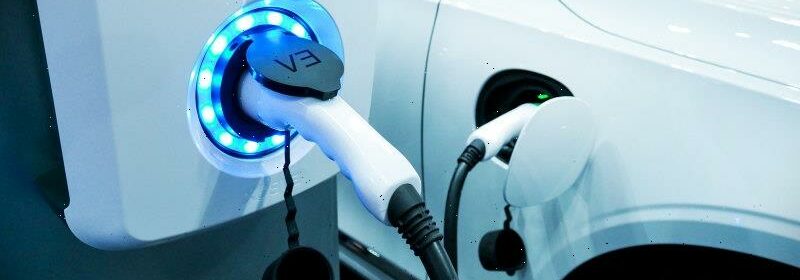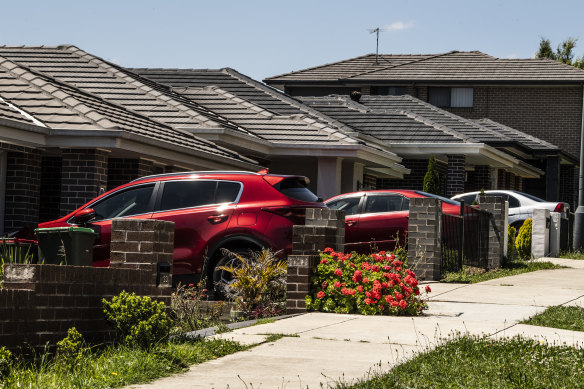Three things Sydney must do to help meet climate targets

Sydney will struggle to meet its net zero target unless it takes more drastic action to reduce its emissions, including doing more to increase the uptake of electric vehicles and electrify homes, a new report has found.
The report, by the urban policy think tank Committee for Sydney, found that under the current trajectory, Sydney’s emissions will only fall by 43 per cent by 2030 and 80 per cent by 2050. These numbers fall short of the state’s targets of reducing emissions by 50 per cent by 2030 and net zero by 2050.
The electrification of vehicles and homes has a significant role to play in reducing Sydney’s emissions.Credit:Louise Kennerley
The race to reach net zero becomes more challenging as the city’s population is expected to swell to 6.1 million by 2041. Sydney houses two-thirds of the state’s population, accounting for 35 per cent of the state’s emissions.
Sydney’s biggest emissions sector is transport which contributes 36 per cent of the city’s emissions, the report found. Of that, 88 per cent are from road transport.
While there has been a significant push to electrify Sydney’s public transport system, there are concerns about how the city will be able to meet its emission targets given the population is set to grow by 50 per cent by 2050.
“The challenge in getting to net zero will be to abate emissions from the expected 150 per cent rise from present-day travelling needs”, the report notes.
The building, industry and waste management sectors contribute 31 per cent, 17 per cent and 7 per cent respectively.
The three solutions: roads, buildings and batteries
The report has found that there needs to be a greater push to get more electric vehicles on the road, including implementing a range of new policies and regulations, incentive schemes and educational programs. It also suggests offering greater investment in public transport and car sharing facilities.
Another major issue will be addressing the city’s building sustainability, with the report calling for new policies to replace gas appliances by 2045, the electrification of business and government buildings and requiring the disclosure of energy efficiency in homes.
Resilience Program Director at the Committee for Sydney Sam Kernaghan said doing both these things come with big social, logistical and political challenges but it will be worth it in the long term.
“Many Australians are deeply concerned about rising costs of living at the moment – this research shows by 2030 household energy costs are modelled to fall significantly with electrification of cars and homes,” he said.
The report notes that Sydney households in the fifth bottom income bracket are spending about 20 per cent of their disposable income on energy costs. This could decrease to 5 per cent if technologies such as rooftop solar, electric vehicles and batteries are implemented.
In comparison, those homes in the highest quintile are spending 3 per cent of their disposable income on electricity costs – which could decrease to 1 per cent if the same technologies were adopted.
“NSW’s climate policies are leading the nation, but this research is a wake-up call that Sydney’s not on track for net zero – we’ve got plenty of work to do,” Kernaghan said.
He added that industry and government needed to lead by example to speed up the transition and introduce regulatory reform.
‘Sydney households in the fifth bottom income bracket are spending about 20 per cent of their disposable income on energy costs.’
The NSW government announced on Monday that new homes and renovations costing more than $50,000 will have to meet a 7-star energy efficiency rating from October next year in NSW under upgraded rules that will force developers to play their part in driving down the state’s emissions.
Large commercial developments, as well as big state projects, will also have to submit a “net-zero statement” that shows their buildings are either all-electric or can fully convert to renewable energy by 2035 if they want approval to proceed.
The third solution is to increase the uptake of distributed energy resources, which include rooftop solar, batteries and storage.
The report suggests:
- greater financial packages for low-income houses are needed
- offer incentives for property managers to invest in solar
- mandate more sustainable energy resources post-2050
Ausgrid chief customer officer Rob Amphlett Lewis said the grid would play a major role in decarbonising the economy, with the company focusing on how it could do this rapidly while also ensuring affordability.
“We know [that] what we do today will have a huge impact on our tomorrow, and it’s imperative as an industry we work together with customers and governments to get it right,” Lewis said.
Federal Assistant Minister for Energy and Climate Change Jenny McAllister said the previous government had done very little to address decarbonisation.
“[There have been] long periods where it has been difficult to talk about these issues at a federal level,” she said. “We are at 100 days of the new Labor government, but we are starting from a long way behind where we would like to be, nationally. The [previous] government had a hard time even saying the word.”
Get to the heart of what’s happening with climate change and the environment. Our fortnightly Environment newsletter brings you the news, the issues and the solutions. Sign up here.
Most Viewed in Environment
From our partners
Source: Read Full Article
